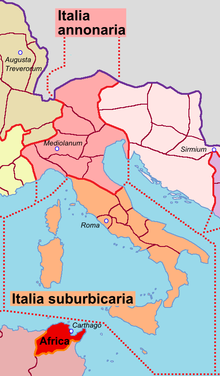Italia suburbicaria (Italy "under the government of the urbs", i.e. Rome) was a vicariate of the late Roman Empire established by Constantine I (306–337).
| Italia suburbicaria | |
|---|---|
 | |
| Capital | Rome |
| Historical era | Late Antiquity and Early Middle Ages |
| Today part of | Italy France Malta |

It included south-central Italy and the islands of Sicily, Sardinia, and Corsica. Its capital was Rome, where the vicarius urbis Romae, the highest civil authority of the vicariate, had its seat.
History
Under Constantine I, the dioecesis Italiciana was divided into two administrative partitions or vicariates, each governed by a vicarius: Italia Suburbicaria and Italia Annonaria.[1] In fact, the sources of the time, such as the Laterculus Veronensis and the Notitia Dignitatum, attest that de jure Italy continued to be subdivided into a single diocese, the dioecesis Italiciana, which in turn was divided into two vicariates.[2] However, since Italia Annonaria and Italia Suburbicaria were each governed by a vicarius (the highest civil authority of a diocese), they are often improperly called dioceses since de facto they were while not being de jure.[3] The vicariate of Italia Suburbicaria included south-central Italy and the islands of Sicily, Sardinia and Corsica. The dividing line between Italia Suburbicaria and Italia Annonaria was placed at the Arno and Esino rivers.[1] The tax in annona and foodstuffs paid by the inhabitants of the vicariate was then used essentially to supply and feed the plebs of Rome.[1] The highest civil authority was the vicarius urbis Romae, resident in Rome. The office probably originated from the so-called agens vices praefectorum praetorium, who, beginning in the Severan age, replaced the Praetorian prefect in commanding the praetorian guard and troops of the capital during his absence from the Urbe.[1] Constantine, after demilitarizing the Urbe to prevent revolts and usurpations (the praetorian guard had supported Maxentius), transformed Rome's agens vices praefectorum praetorio into the vicarius urbis Romae, stripping him of all military power and making him the highest civil authority in Italia Suburbicaria.[1]
At the time of the Laterculus Veronensis (drafted around 314 AD) it probably consisted of the following provinces:[4]
At the time of the Notitia Dignitatum (written around 395 AD and updated for the West until around 420 AD) it consisted of the following ten provinces:
- Tuscia et Umbria (Tuscany, Umbria and the northern part of coastal Lazio)
- Picenum Suburbicarium (Piceno, in southern Marche)
- Valeria (northern Latium and southern Umbria)
- Campania (central and southern coastal Lazio and coastal Campania except for the modern province of Salerno)
- Samnium (Abruzzo, Molise, Sannio e Cassino)
- Apulia et Calabria (Puglia e Salento, and Irpinia)
- Lucania et Bruttii (Cilento, Basilicata e Calabria)
- Sicilia (Sicily and Malta)
- Sardinia
- Corsica
Even after the fall of the Western Roman Empire, the diocese seems to have survived: in fact still in the late 6th/early 7th century (Byzantine era) deputies of the prefects of the praetorium (agentes vices), or vicarii, in Genoa and Rome are mentioned in papal epistles.[5][6] However, it seems that by the end of the 6th century the office of vicarius had lost much prestige, both because of the growing importance of military officers, who often arrogated to themselves powers that would normally have fallen to civilian officers, and because of the conquests of the Longobards.[7] Already in Ostrogothic times, the vicarius urbis Romae had lost the government of the diocese, becoming, according to Hartmann, a collaborator of the praefectus urbi; the vicar's jurisdiction had been reduced to the city of Rome and its surroundings up to 40 miles away from the city.[5][6] Cosentino, on the other hand, denies Hartmann's thesis, pointing out that in 557 the vicarii are still attested as dependent on the prefect of the praetorium of Italy and not on the praefectus urbi.[5] By the end of the sixth century, in the Byzantine era, it appears that the vicarii were only concerned with the management of finances, having lost much of their former authority.[6] The vicarius urbis Romae seems to have become at the end of the 6th century even less important than the praefectus urbi and then disappeared from the sources for good.[8]
References
Diehl
— p. 162.
Diehl
— p. 165.